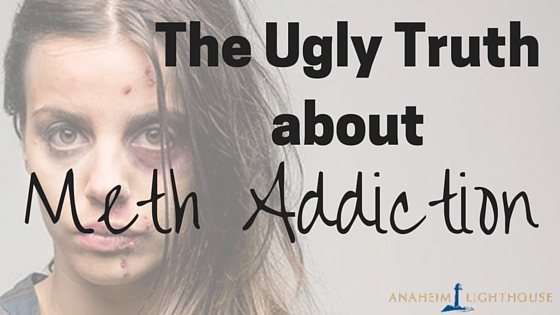The Ugly Truth about Meth Addiction- and why NOT doing it is a good decision!

One of the most popular drugs abused today is methamphetamine. According to the 2012 National Survey on Drug use and health, approximately 1.2 million people (that's 0.4% of the population) reported using methamphetamine in the past year. Half of those people reported using it in the past month! Although using statistics are decreasing from previous years, these numbers are extremely high- just like the dopamine levels once methamphetamine enters the system. Meth releases a surge of dopamine, causing an intense rush of pleasure or prolonged sense of euphoria. Over time, the drug destroys dopamine receptors, making it impossible to feel pleasure without it. Although these pleasure centers can heal over time, it has been researched and suggested that the damage done to the users' cognitive abilities may actually be permanent.
"There are a whole variety of reasons to try methamphetamine," explains Dr. Richard Rawson, associate director of UCLA's Integrated Substance Abuse Programs. "However, once they take the drug, their reasons are pretty much the same. They all like how it FEELS." It's been described as "a sudden rush of pleasure lasting for several minutes, followed by a euphoric high that lasts between 6 and 12 hours. This is the result of the drug causing the brain to release excessive amounts of the chemical dopamine, a neurotransmitter that controls pleasure. Meth is no different from any other drug in the way that when abused, it causes the release of dopamine, even alcohol and nicotine does this. Users have claimed meth to be "the MOTHER of all dopamine releases.
But meth isn't all it's cracked up to be, no pun intended. Repeated meth use changes the brain chemistry, destroying the wiring in the brain's pleasure centers and making it almost impossible to experience any pleasure at all without the drugs! Although the brain is capable of naturally repairing itself, it's been reported that even after 14 months of sobriety (abstinence from the drug), the ex users showed no improvement in the cognitive abilities damaged by the drug. Furthermore, after another year sober, these former meth users still showed severe impairment in memory, judgment and motor skills. These symptoms all resemble the symptoms of someone suffering from Parkinson's Disease.
Violence has also been known to occur while using meth. Like all good stimulants, Meth causes the brain to release large doses of adrenaline. This, being the bodies "fight or flight" mechanism, induces anxiety, wakefulness, and intensely focused attention- this is also known as "tweaking." Tweaking or tweakers are hyperactive and obsessive with their behaviors. Heavy chronic usage can also prompt psychotic behavior such as
- paranoia
- agression
- hallucinations
- delusions
Some users have even reported the feeling of having insects crawling beneath their skin! Even after 5 years of sobriety, a former user reports not being able to go to the bathroom without propping a space heater against the door, in case someone is after him.
Visible signs of Meth abuse include
- acne
- sores that don't appear to heal
- skin that no longer has elasticity, eluding to increased age
- tooth decay and tooth loss- "Meth mouth"
- extreme weight loss
- Poor Hygiene
Other effects Meth has on the body include
- increased heart rate
- disorganized lifestyle
- lowered resistance to illness
- liver damage
- convulsions
- brain damage
- stroke
- death
In conclusion, methamphetamine is toxic and dangerous to your permanent health. Like many other drugs, it is only a temporary solution- which ends up causing a long term problem. If you or someone you know is struggling with meth addiction, call the Anaheim Lighthouse Today, we can help start your recovery.
Resources:
http://www.pbs.org/wgbh/pages/frontline/meth
http://www.drugabuse.gov/publications/research-reports/methamphetamine













